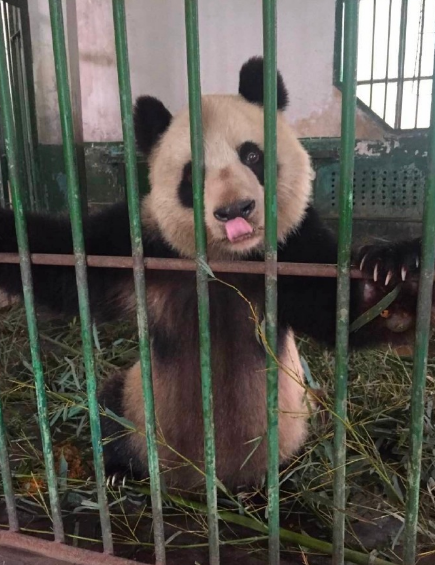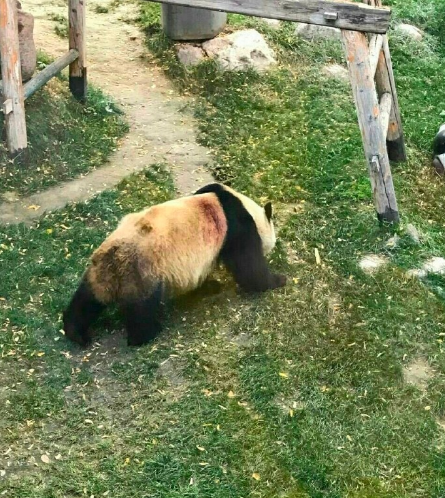Giant pandas are severely abused in China
Wang Jimin
October 17, 2024
This is just the tip of the iceberg of the suffering of giant pandas returned by the United States under the so-called "Panda Conservation Project" in Chengdu, China.
Image copyright©️
[New Sancai Compilation and First Release] Americans pay tens of millions of dollars to China every year to rent giant pandas to zoos across the United States. According to the Giant Panda Conservation Plan, U.S. zoos spend about $1 million per pair of giant pandas each year, with an additional $500,000 spent if cubs are born. Under the U.S.-China agreement, once the baby pandas reach three or four years old, the zoo must return them to China for a breeding program. About 20 countries around the world have plans similar to China's. Not only has the program generated billions of dollars in revenue for China's one-party Communist regime, it has also expanded the regime's influence through the panda's popularity.
Led by the Smithsonian's National Zoo, many U.S. zoos have been involved in giant panda conservation programs for decades. The program has become a financial boon to the Chinese Communist Party, promoting the development of large panda captive facilities in China, where giant pandas endure worse nightmares. The Chinese government's top priority is to maximize the reproduction and economic benefits of giant pandas, but this often comes at the expense of the physical and mental health of the giant pandas. Taking advantage of Chinese government censorship, there is little information about how foreign panda funds are spent and how these American-born pandas are treated in China.

When these giant pandas are returned to China, they often find themselves living in cramped, filthy and neglected facilities without proper care. In stark contrast, their overseas environments are closely monitored and cared for by dedicated teams of American scientists and volunteers. Therefore, these foreign-born giant pandas face huge challenges in adapting to the harsh environment and coping with the abuse of living conditions.

More online reports indicate that these giant pandas are continuously beaten, sexually abused, mentally tortured and injured in zoos and research institutions in China. They will be tied to the table multiple times in a short period of time against their will and undergo a painful reproductive process that often results in injuries, vomiting, mental stress, and even death.
According to a recent report in The New York Times, none of the U.S.-born giant pandas have been released into the wild. Allowing giant pandas to live and survive in the wild is the main message of the U.S.-initiated giant panda conservation program, but all of these giant pandas are undergoing large-scale captive breeding after returning to China. The cruel procedure is performed by a small team of zoo staff and scientists, and little is known about the process. In addition to this repetitive process of destroying giant pandas’ natural breeding habits, giant pandas in China are trained and forced to be photographed and hugged by tourists. These constant human interactions and threat-driven training deprive them of every opportunity to return to the wild. An opportunity.
When giant pandas grow old, these overused animals will be abandoned and left somewhere in a Chinese zoo.

While the exact number of giant pandas injured or killed as a result of these actions remains unknown, leaked footage from a prominent research institute in Chengdu, China, reveals horrific scenes. In the video, workers drag and toss the cubs, accompanied by loud shouting.
The following article was published by the BBC in 2017:
The incident drew criticism from Chinese netizens, who expressed concerns about animal cruelty.
However, giant panda keeper Guo Jingpeng defended himself, saying the cubs were prone to violence.
Mr Guo told Xinhua, the state news agency, that the video did not show him being bitten while feeding.
"The cub bit my hand hard. Its teeth dug into my flesh and my hand started bleeding," he said, adding that his hand was still scarred.
"When he tried to bite me again, I instinctively pushed him away."
Mr Guo also said he felt he had been wronged by the video, recorded in early July, which circulated online this week.
"The online community claims that we don't like pandas. But we choose to stay and work because we like these creatures," he told local media.
"I just want to clarify that the shot of me 'throwing' the panda was a natural reaction."
Mr Guo's colleagues told local media that he had since been "criticized and educated" by the facility.
The giant panda is considered a symbol of China and is a species highly protected by the government.
The official giant panda facility in Chengdu, Sichuan Province, is dedicated to protecting the species, which is no longer considered endangered.
"Pandas look cute, but they can also be [violent]."
The controversial interaction caused a stir in China, a country that loves giant pandas.
On the popular Sina Weibo site, many called for Mr Guo to resign over his "rough treatment" of the cubs.
"I don't care what he has to say, they are just babies," wrote Lu Jiaying from Beijing.
"It made me very angry to see him throwing a defenseless cub around. If he was so worried about his safety, why wasn't he wearing protective gear like gloves?"
Other netizens called it "blatant animal cruelty" and expressed anger at the situation.
One Weibo user questioned the entire government facility. "We always thought the Chengdu center was set up to save our national animal. It has done a good job in the past and made many Chinese happy with photos of baby pandas," he wrote.
"This incident really changed my perspective on its operations and goals."
(Source: China, BBC)
(Compiled by: Wang Jimin)
(Editor: Jiang Qiming)
(Source of the article: Compiled and published by New Sancai)
